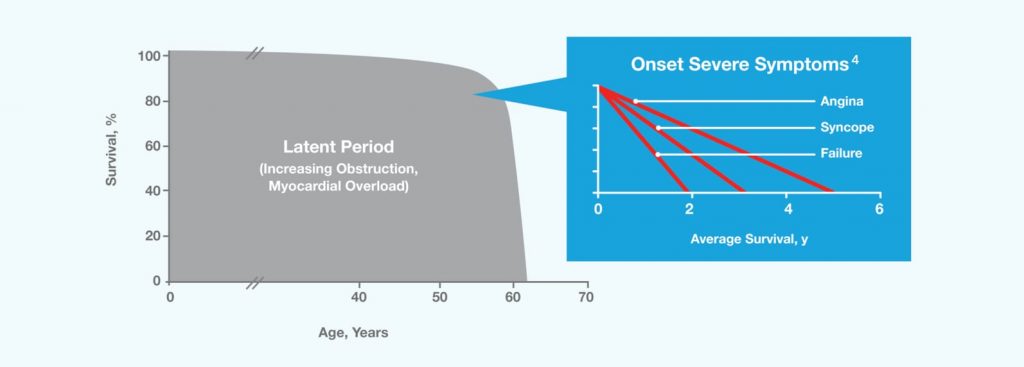Symptoms and Signs of Aortic Stenosis
Many patients with aortic stenosis may not show symptoms or signs of the disease.
Many symptoms may present only during exercise or performing activities of daily living. In this instance, many elderly patients may decrease their exertional levels to mask the symptoms of this disease.
Symptoms of a diseased aortic valve may present as either moderate to severe, depending on the level of stenosis of the affected valve.
In the below video, Interventional Cardiologist Dr Mark Webster lists the symptoms to look out for in aortic stenosis patients, including exertional chest discomfort, breathlessness, and syncope or dizziness. He further explains that patients with mild aortic stenosis will often not experience any symptoms until their condition has progressed to severe.
It has been suggested that up to 1 in 3 patients over the age of 75 may be symptomatic when asked by their doctor. Many of these signs may be put down to “ageing” as they may be vague when taking a patient history.
Aortic stenosis symptoms and signs can present as:
- Breathlessness on exertion
- Chest pain/ Angina during exertion
- Fatigue
- Decreased exercise tolerance over the past 6-12 months
- Syncope/pre syncope
- Signs of heart failure (for example, swollen ankles)
- Rapid irregular pulse rates 1
Those patients at home with untreated aortic stenosis may be living with considerable impact on their quality of life, with many limiting their activity levels due to symptoms. These patients are often at risk of frequent episodes of hospitalisation, which increases the financial burden of this disease to the community2.
Main Causes of Aortic Stenosis
Calcium Build-up
In many adults, calcium builds up around the aortic valve leaflets and makes them stiff and heavy, thus reducing the ability to open and close fully. Calcium build-up is the most common form of aortic stenosis.
Birth Defects
A Bicuspid valve is a genetic valve condition where patients most commonly may have two leaflets instead of three within the aortic valve. These birth defects may cause the aortic valve to be susceptible to regurgitation and aortic stenosis.
Rheumatic Fever
In some cases, rheumatic fever may cause the aortic valve to be damaged or scarred when a patient is exposed to strep throat. When this occurs, the aortic valve may not function as it normally should and may require replacement of the damaged valve3.
Red Flags to Consider During a Patient History
There are several red flags to be looking for when assessing your patient for aortic stenosis. The cardinal symptoms of aortic stenosis may all be exacerbated by exercise.
These include:
- Exertional angina,
- Breathlessness,
- Dizziness/syncope,
- Signs of heart failure
Cardiothoracic Surgeon Mr Peter Alison explains the red flags he looks out for in patients who are potentially showing signs of aortic stenosis or heart failure, including patients, “who [are] complaining of chest pain, exertional shortness of breath, increasing fatigue… and a murmur.”
Another key consideration is a significant change in activity levels over the past 6-12 months. As many patients with aortic stenosis are asymptomatic, it is also important to as a family member or partner if they have noticed a change in functional levels as many patients put these signs down to “old age.”
The onset of symptoms indicates a worse prognosis and can be associated with approximately 50% mortality at two years. The presence of a heart murmur should alert the physician to immediate referral to a cardiologist for consideration of treatment.
Important! Ask relatives if they have noticed any changes to the patient’s physical activity levels.
Tips for Taking a Patient History
Examination
If aortic stenosis is suspected, then a detailed discussion around the changes in functional exercise over the past 6-12 months should occur.
The rhythm of the pulse tends to be of low volume, reflecting the reduction in flow across the narrowed valve, which is most prominent in the carotid region where the pressure on the palpating finger slowly rises to maximum amplitude (slow rising pulse).
Pulse character
Narrow
Pulse pressure
Low pressure, slow rising
Apex beat
Normal
Murmur
Systolic murmur (crescendo-decrescendo)
Additional features
Soft S24
Quality of Life Impact with Aortic Stenosis
Many patients with aortic stenosis may also have advanced symptoms that impact on their ability to meet their activities of daily living and may affect the ability of these patients to be able to provide self-care at home. Aortic stenosis is a mechanical problem that may require a mechanical solution to alleviate these symptoms. However, it is estimated that only approximately 1 in 3 patients receive valve replacements each year5.
“Patients are not able to look after themselves,” Interventional Cardiologist Dr Raj Nair explains below, discussing the decreased quality of life patients with severe aortic stenosis will have as they increasingly cannot perform their daily activities. He further explains the issue of reoccurring hospitalisation as some patients may not receive treatment if they are considered too high-risk or futile, and can be admitted to hospital for heart failure symptoms.
There is a long “latent period” during which patients with aortic stenosis may not exhibit signs or symptoms of the disease. Once a patient exhibits symptoms of aortic stenosis, urgent treatment is required.
Patients with severe aortic stenosis have a survival rate as low as 50% at 2 years, and 20% at 5 years without aortic valve replacement. Symptomatic aortic stenosis will eventually lead to death without treatment6.

Without treatment survival rates in patients with severe aortic stenosis are as low as 50% at two years.

Patient Disclaimer: All content on the Hope For Hearts site is created and published online for general information purposes only. It is not intended to be a substitute for professional medical advice and should not be relied on as health or personal advice. Please see your doctor if you have any questions or concerns.
Reference
- Mayo Clinic Staff
- Nishimura R, Otto C, Bonow R, et al. 2014 AHA/ACC Guideline for the Management of Patients with Valvular Heart Disease. J AM Coll Cardiol. 2014;63(22):57-185.
- Cleveland Clinic
- GPOnline
- Bouma B, van den Brink R, van der Meulen J, et al. To operate or not on elderly patients with aortic stenosis: the decision and its consequences. Heart. 1999;82(2):143-148.
- Lester S, Heilbron B, Dodek A, Gin K, Jue J. The Natural History and Rate of Progression of Aortic Stenosis. Chest. 1998;113(4):1109.
